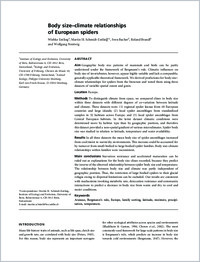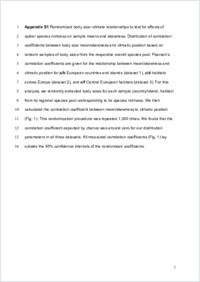Body size–climate relationships of European spiders
- Entling, Wiebke Institute of Ecology and Evolution, University of Bern, Switzerland
- Schmidt-Entling, Martin H. Institute of Ecology and Evolution, University of Bern, Switzerland
- Bacher, Sven Ecology and Evolution, University of Fribourg, Switzerland
- Brandl, Roland Animal Ecology, Philipps-University Marburg, Marburg, Germany
- Nentwig, Wolfgang Institute of Ecology and Evolution, University of Bern, Switzerland
-
08.10.2009
Published in:
- Journal of Biogeography. - 2010, vol. 37, no. 3, p. 477-485
English
Aim: Geographic body size patterns of mammals and birds can be partly understood under the framework of Bergmann's rule. Climatic influences on body size of invertebrates, however, appear highly variable and lack a comparable, generally applicable theoretical framework. We derived predictions for body size–climate relationships for spiders from the literature and tested them using three datasets of variable spatial extent and grain. Location: Europe. Methods: To distinguish climate from space, we compared clines in body size within three datasets with different degrees of co-variation between latitude and climate. These datasets were: (1) regional spider faunas from 40 European countries and large islands; (2) local spider assemblages from standardized samples in 32 habitats across Europe; and (3) local spider assemblages from Central European habitats. In the latter dataset climatic conditions were determined more by habitat type than by geographic position, and therefore this dataset provided a non-spatial gradient of various microclimates. Spider body size was studied in relation to latitude, temperature and water availability. Results: In all three datasets the mean body size of spider assemblages increased from cool/moist to warm/dry environments. This increase could be accounted for by turnover from small-bodied to large-bodied spider families. Body size–climate relationships within families were inconsistent. Main conclusions: Starvation resistance and accelerated maturation can be ruled out as explanations for the body size clines recorded, because they predict the inverse of the observed relationship between spider body size and temperature. The relationship between body size and climate was partly independent of geographic position. Thus, the restriction of large-bodied spiders to their glacial refugia owing to dispersal limitations can be excluded. Our results are consistent with mechanisms invoking metabolic rate, desiccation resistance and community interactions to predict a decrease in body size from warm and dry to cool and moist conditions.
- Faculty
- Faculté des sciences et de médecine
- Department
- Département de Biologie
- Language
-
- English
- Classification
- Biology, life sciences
- License
-
License undefined
- Identifiers
-
- RERO DOC 12936
- DOI 10.1111/j.1365-2699.2009.02216.x
- Persistent URL
- https://folia.unifr.ch/unifr/documents/301231
Other files
Statistics
Document views: 179
File downloads:
- pdf: 350
- Supplementary material: 159

